Want to catch up with other articles from this series?
- The straight dope on cholesterol – Part I
- The straight dope on cholesterol – Part II
- The straight dope on cholesterol – Part III
- The straight dope on cholesterol – Part IV
- The straight dope on cholesterol – Part V
- The straight dope on cholesterol – Part VI
- The straight dope on cholesterol – Part VII
- The straight dope on cholesterol – Part VIII
- The straight dope on cholesterol – Part IX
Previously, across 8 parts of this series we’ve laid the groundwork to ask perhaps the most important question of all:
What should you eat to have the greatest chance of delaying the arrival of cardiovascular disease?
Before we get there, since this series has been longer and more detailed than any of us may have wanted, it is probably worth reviewing the summary points from the previous posts in this series (or you can just skip this and jump to the meat of this post).
What we’ve learned so far
- Cholesterol is “just” another fancy organic molecule in our body but with an interesting distinction: we eat it, we make it, we store it, and we excrete it – all in different amounts.
- The pool of cholesterol in our body is essential for life. No cholesterol = no life.
- Cholesterol exists in 2 forms – unesterified or “free” (UC) and esterified (CE) – and the form determines if we can absorb it or not, or store it or not (among other things).
- Much of the cholesterol we eat is in the form of CE. It is not absorbed and is excreted by our gut (i.e., leaves our body in stool). The reason this occurs is that CE not only has to be de-esterified, but it competes for absorption with the vastly larger amounts of UC supplied by the biliary route.
- Re-absorption of the cholesterol we synthesize in our body (i.e., endogenous produced cholesterol) is the dominant source of the cholesterol in our body. That is, most of the cholesterol in our body was made by our body.
- The process of regulating cholesterol is very complex and multifaceted with multiple layers of control. I’ve only touched on the absorption side, but the synthesis side is also complex and highly regulated. You will discover that synthesis and absorption are very interrelated.
- Eating cholesterol has very little impact on the cholesterol levels in your body. This is a fact, not my opinion. Anyone who tells you different is, at best, ignorant of this topic. At worst, they are a deliberate charlatan. Years ago the Canadian Guidelines removed the limitation of dietary cholesterol. The rest of the world, especially the United States, needs to catch up. To see an important reference on this topic, please look here.
- Cholesterol and triglycerides are not soluble in plasma (i.e., they can’t dissolve in water) and are therefore said to be hydrophobic.
- To be carried anywhere in our body, say from your liver to your coronary artery, they need to be carried by a special protein-wrapped transport vessel called a lipoprotein.
- As these “ships” called lipoproteins leave the liver they undergo a process of maturation where they shed much of their triglyceride “cargo” in the form of free fatty acid, and doing so makes them smaller and richer in cholesterol.
- Special proteins, apoproteins, play an important role in moving lipoproteins around the body and facilitating their interactions with other cells. The most important of these are the apoB class, residing on VLDL, IDL, and LDL particles, and the apoA-I class, residing for the most part on the HDL particles.
- Cholesterol transport in plasma occurs in both directions, from the liver and small intestine towards the periphery and back to the liver and small intestine (the “gut”).
- The major function of the apoB-containing particles is to traffic energy (triglycerides) to muscles and phospholipids to all cells. Their cholesterol is trafficked back to the liver. The apoA-I containing particles traffic cholesterol to steroidogenic tissues, adipocytes (a storage organ for cholesterol ester) and ultimately back to the liver, gut, or steroidogenic tissue.
- All lipoproteins are part of the human lipid transportation system and work harmoniously together to efficiently traffic lipids. As you are probably starting to appreciate, the trafficking pattern is highly complex and the lipoproteins constantly exchange their core and surface lipids.
- The measurement of cholesterol has undergone a dramatic evolution over the past 70 years with technology at the heart of the advance.
- Currently, most people in the United States (and the world for that matter) undergo a “standard” lipid panel, which only directly measures TC, TG, and HDL-C. LDL-C is measured or most often estimated.
- More advanced cholesterol measuring tests do exist to directly measure LDL-C (though none are standardized), along with the cholesterol content of other lipoproteins (e.g., VLDL, IDL) or lipoprotein subparticles.
- The most frequently used and guideline-recommended test that can count the number of LDL particles is either apolipoprotein B or LDL-P NMR, which is part of the NMR LipoProfile. NMR can also measure the size of LDL and other lipoprotein particles, which is valuable for predicting insulin resistance in drug naïve patients, before changes are noted in glucose or insulin levels.
- The progression from a completely normal artery to a “clogged” or atherosclerotic one follows a very clear path: an apoB containing particle gets past the endothelial layer into the subendothelial space, the particle and its cholesterol content is retained, immune cells arrive, an inflammatory response ensues “fixing” the apoB containing particles in place AND making more space for more of them.
- While inflammation plays a key role in this process, it’s the penetration of the endothelium and retention within the endothelium that drive the process.
- The most common apoB containing lipoprotein in this process is certainly the LDL particle. However, Lp(a) and apoB containing lipoproteins play a role also, especially in the insulin resistant person.
- If you want to stop atherosclerosis, you must lower the LDL particle number. Period.
- At first glance it would seem that patients with smaller LDL particles are at greater risk for atherosclerosis than patients with large LDL particles, all things equal.
- “A particle is a particle is a particle.” If you don’t know the number, you don’t know the risk.
- With respect to laboratory medicine, two markers that have a high correlation with a given outcome are concordant – they equally predict the same outcome. However, when the two tests do not correlate with each other they are said to be discordant.
- LDL-P (or apoB) is the best predictor of adverse cardiac events, which has been documented repeatedly in every major cardiovascular risk study.
- LDL-C is only a good predictor of adverse cardiac events when it is concordant with LDL-P; otherwise it is a poor predictor of risk.
- There is no way of determining which individual patient may have discordant LDL-C and LDL-P without measuring both markers.
- Discordance between LDL-C and LDL-P is even greater in populations with metabolic syndrome, including patients with diabetes. Given the ubiquity of these conditions in the U.S. population, and the special risk such patients carry for cardiovascular disease, it is difficult to justify use of LDL-C, HDL-C, and TG alone for risk stratification in all but the most select patients.
- To address this question, however, one must look at changes in cardiovascular events or direct markers of atherosclerosis (e.g., IMT) while holding LDL-P constant and then again holding LDL size constant. Only when you do this can you see that the relationship between size and event vanishes. The only thing that matters is the number of LDL particles – large, small, or mixed.
- HDL-C and HDL-P are not measuring the same thing, just as LDL-C and LDL-P are not.
- Secondary to the total HDL-P, all things equal it seems smaller HDL particles are more protective than large ones.
- As HDL-C levels rise, most often it is driven by a disproportionate rise in HDL size, not HDL-P.
- In the trials which were designed to prove that a drug that raised HDL-C would provide a reduction in cardiovascular events, no benefit occurred: estrogen studies (HERS, WHI), fibrate studies (FIELD, ACCORD), niacin studies, and CETP inhibition studies (dalcetrapib and torcetrapib). But, this says nothing of what happens when you raise HDL-P.
- Don’t believe the hype: HDL is important, and more HDL particles are better than few. But, raising HDL-C with a drug isn’t going to fix the problem. Making this even more complex is that HDL functionality is likely as important, or even more important, than HDL-P, but no such tests exist to “measure” this.
Did you say “delay?”
That’s right. The question posed above did not ask how one could “prevent” or eliminate the risk cardiovascular disease, it asked how one could “delay” it. There is a difference. To appreciate this distinction, it’s worth reading this recent publication by Allan Sniderman and colleagues. Allan sent me a copy of this paper ahead of publication a few months ago in response to a question I had posed to him over lunch one day. I asked,
“Allan, who has a greater 5-year risk for cardiovascular disease, a 25 year-old with a LDL-P/apoB in the 99th percentile or a 75-year-old with a LDL-P/apoB in the 5th percentile?”
The paper Allan wrote is noteworthy for at least 2 reasons:
- It’s an excellent reminder that age is a paramount risk factor for cardiovascular disease.
- It provides a much better (causal) model for atherosclerosis than the typical age-driven models, and explains why age is an important risk factor.
What do I mean by this? Most risk calculators (e.g., Framingham) take their inputs (e.g., age, gender, LDL-C, HDL-C, smoking, diabetes, blood pressure) and calculate a 10-year risk score. If you’ve ever played with these models you’ll quickly see that age drives risk more than any other input. But why? Is there something inherently “risky” about being older?
Sniderman and many others would argue (and I agree) that the reason age is a strong predictor of risk has to do with exposure to apoB particles — LDL, Lp(a), and apoB-carrying remnants. Maybe it’s because I’m a math geek, but such models just seem intuitive to me because I think of most things in life in terms of calculus, especially integrals, the “area under a curve.”
[I once tried to explain to a girlfriend who thought I wasn’t spending enough time with her that my interest in her should be thought of in terms of the area under the curve, rather than any single point in time. That is, think in terms of the integral function, not the point-in-time function. Needless to say, she broke up with me on the spot (in the middle of a parking lot!), despite me drawing a very cool picture illustrating the difference, which I’ve re-created, below.]
The reason age is such a big driver of risk is that the longer your artery walls are exposed to the insult of apoB particles, the more likely they are to be damaged, for all the reasons we covered in Part IV of this series. [This paper also reviews the clinical situation of PCSK9 mutations which builds a very compelling case for the causal model of apoB particles in the development of atherosclerosis].
What does eating have to do with cardiovascular risk?
So now that everyone is on the edge of their seat in anticipation of this punch-line, let me provide two important caveats.
First, there are no long-term studies – either in primary or secondary prevention – examining the exact question we all want to know the answer to with respect to the role of dietary intervention on cardiovascular disease. There are short-term studies, some of which I will highlight, which look at proxies for cardiovascular disease, but all of the long-term studies (looking at secondary prevention), are either drug studies or multiple intervention studies (e.g., cholesterol-lowering drug(s) + blood pressure reducing drug(s) + dietary intervention + exercise + …).
In other words, the “dream” study has not been done and won’t be done for a long time. The “dream” study would follow 2 randomized groups for many years and only make one change between the groups. Group 1 would consume a standard American diet and group 2 would consume a very-low carbohydrate diet. Furthermore, compliance within each group would be excellent (many ways to ensure this, but none of them are inexpensive – part of why this has not been done) and the study would be powered to detect “hard outcomes” (e.g., death), instead of just “soft outcomes” (e.g., changes in apoB, LDL-C, LDL-P, TG).
Second, everything we have learned to date on the risk relationship between cardiovascular disease and risk markers is predicated on the assumption that a risk maker of level X in a person on diet A is the same as it would be for a person on diet B.
Since virtually all of the thousands of subjects who have made up the dozens of studies that form the basis for our understanding on this topic were consuming some variant of the “standard American diet” (i.e., high-carb), it is quite possible that what we know about risk stratification is that this population is not entirely fit for extrapolation to a population on a radically different diet (e.g., a very-low carbohydrate diet or a ketogenic diet). Many of you have asked about this, and my comments have always been the same. It is entirely plausible that an elevated level of LDL-P or apoB in someone consuming a high-carb diet portends a greater risk than someone on a ketogenic or low-carb diet. There are many reasons why this might be the case, and there are many folks who have made compelling arguments for this hypothesis.
But we can’t forget the words of Thomas Henry Huxley, who said, “The great tragedy of science is the slaying of a beautiful hypothesis by an ugly fact.” Science is full of beautiful hypothesis slayed by ugly facts. Only time will tell if this hypothesis ends up in that same graveyard, or changes the way we think about lipoproteins and atherosclerosis.
The role of sugar in cardiovascular disease
Let’s start with what we know, then fill in the connections, with the goal of creating an eating strategy for those most interested in delaying the onset of cardiovascular disease.
There are several short-term studies that have carefully examined the impact of sugar, specifically, on cardiovascular risk markers. Let’s examine one of them closely. In 2011 Peter Havel and colleagues published a study titled Consumption of fructose and HFCS increases postprandial triglycerides, LDL-C, and apoB in young men and women. If you don’t have access to this journal, you can read the study here in pre-publication form. This was a randomized trial with 3 parallel arms (no cross-over). The 3 groups consumed an isocaloric diet (to individual baseline characteristics) consisting of 55% carbohydrate, 15% protein, and 30% fat. The difference between the 3 groups was in the form of their carbohydrates.
Group 1: received 25% of their total energy in the form of glucose
Group 2: received 25% of their total energy in the form of fructose
Group 3: received 25% of their total energy in the form of high fructose corn syrup (55% fructose, 45% glucose)
The intervention was relatively short, consisting of both an inpatient and outpatient period, and is described in the methodology section.
Keep in mind, 25% of total energy in the form of sugar is not as extreme as you might think. For a person consuming 2,400 kcal/day this amounts to about 120 pounds/year of sugar, which is slightly below the average consumption of annual sugar in the United States. In that sense, the subjects in Group 3 can be viewed as the “control” for the U.S. population, and Group 1 can be viewed as an intervention group for what happens when you do nothing more in your diet than remove sugar, which was the first dietary intervention I made in 2009.
Despite the short duration of this study and the relatively small number of subjects (16 per group), the differences brought on by the interventions were significant. The figure below shows the changes in serum triglycerides via 3 different ways of measuring them. Figure A shows the difference in 24-hour total levels (i.e., the area under the curve for serial measurements – hey, there’s our integral function again!). Figure B shows late evening (post-prandial) differences. Figure C shows the overall change in fasting triglyceride level from baseline (where sugar intake was limited for 2 weeks and carbohydrate consumption consisted only of complex carbohydrates).
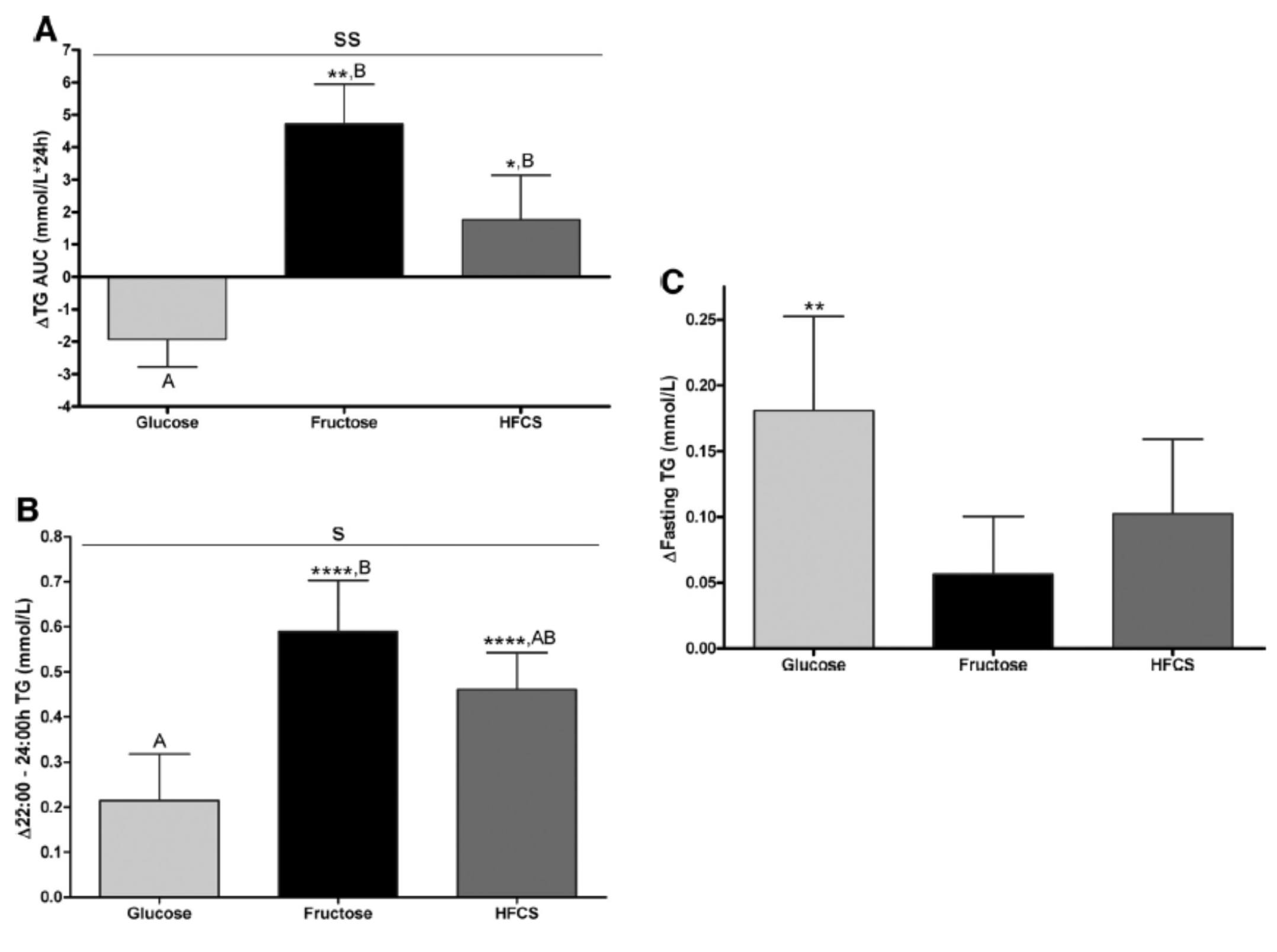
The differences were striking. The group that had all fructose and HFCS removed from their diet, despite still ingesting 55% of their total intake in the form of non-sugar carbohydrates, experienced a decline in total TG (Figure A, which represents the daily integral of plasma TG levels, or AUC). However, that same group experienced the greatest increase in fasting TG levels (Figure C). Post-prandial TG levels were elevated in all groups, but significantly higher in the fructose and HFCS groups (Figure B). The question this begs, of course, is which of these measurements is most predictive of risk?
Historically, fasting levels of TG are used as the basis of risk profiling (Figure C), and according to this metric glucose consumption appears even worse than fructose or HFCS. However, recent evidence suggests that post-prandial levels of TG (Figure B) are a more accurate way to assess atherosclerotic risk, as seen here, here, and here. One question I have is why did the AUC calculations in Figure A show a reduction in plasma TG level for the glucose group?
The figure below summarizes the differences in LDL-C, non-HDL-C, apoB, and apoB/apoA-I.
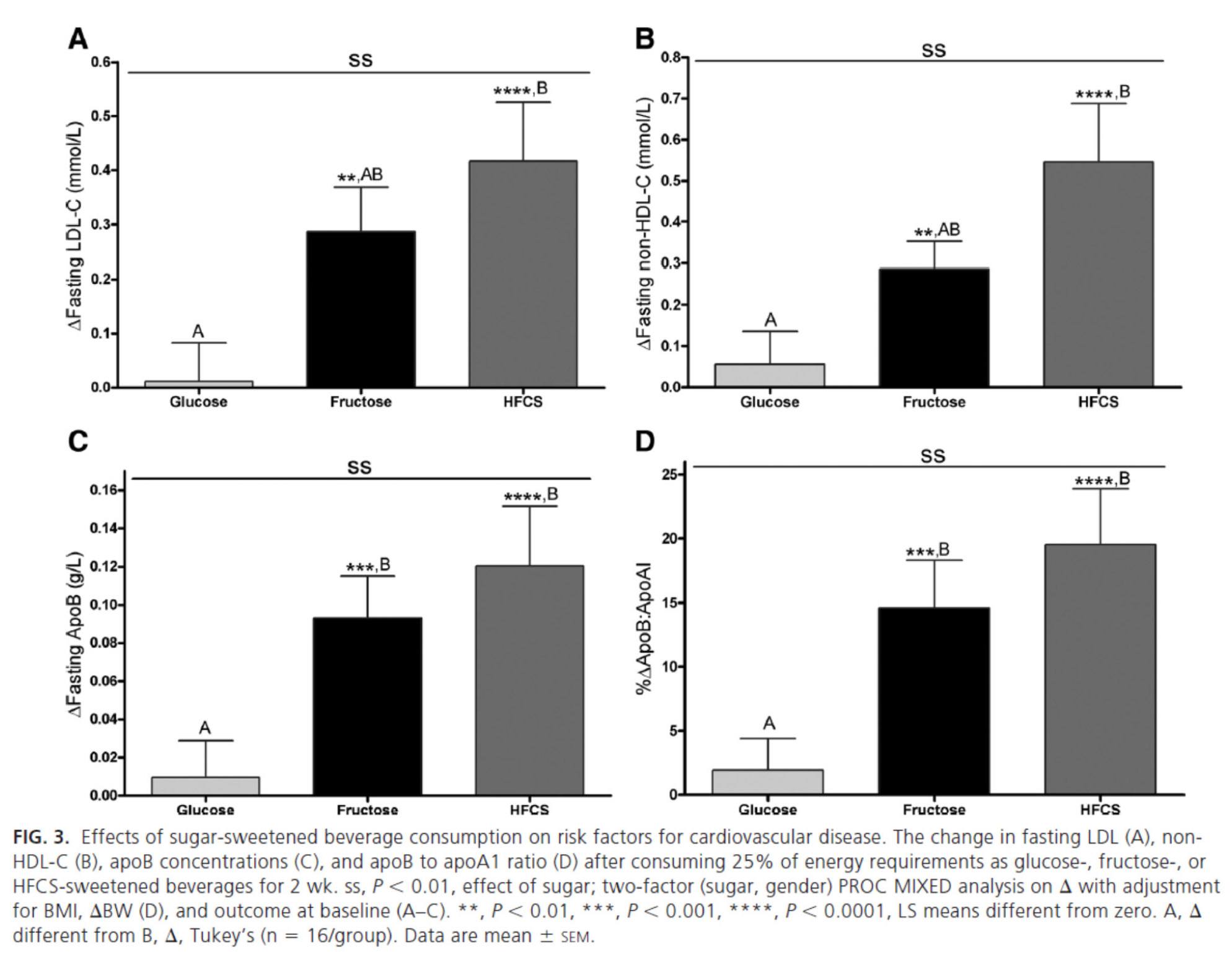
Again, the results were unmistakable with respect to the impact of fructose and HFCS on lipoproteins, and by extension, the relative lack of harm brought on by glucose in isolation. [Of course, removal of glucose and fructose/HFCS would have been a very interesting control group.]
One of the simultaneous strengths and weaknesses of this study was the heterogeneity of its subjects, who ranged in BMI from 18 to 35, in age from18 to 40, and in gender. While this provided at least one interesting example of age-related differences in carbohydrate metabolism (older subjects had a greater increase in triglycerides in response to glucose than younger subjects), it may have actually diluted the results. There were also significant differences between genders in the glucose group.
What was most interesting about this study was the clear difference between the 3 groups that was not solely a function of fructose load. In other words, the best outcome from a disease risk standpoint was in the glucose group, while the worst outcome was not in the all-fructose group, but in the 50/50 (technically 55/45) mixed group. This is a very powerful indication that while glucose and fructose alone can be deleterious in excess, their combination seems synergistically bad.
The role of saturated fat in cardiovascular disease
In the next week or two I’ll be posting an hour-long comprehensive lecture I gave at UCSD a few weeks ago on this exact topic. Rather than repeat any of it here, I’ll highlight one study that I did not include in that lecture. The study, Effect of a high saturated fat and no-starch diet on serum lipid subfractions in patients with documented atherosclerotic cardiovascular disease, published in 2003, treated 23 obese patients (average BMI 39) with known cardiovascular disease (status post coronary artery bypass surgery and/or stent placement) with a high-fat ketogenic diet. Because the study was free-living and relied on self-reporting, not all subjects had documented levels of elevated serum B-OHB. However, the subjects were instructed to avoid starch and consume 50% of their caloric intake via saturated fat, primarily in the form of red meat and cheese. There were no restrictions on fruits and vegetables, which may have accounted for the observation that not all subjects were ketotic during the 6-week intervention. In total, only 5 of the 23 patients achieved documented ketosis.
All of the subjects were on statins and entered the study at a goal LDL-C level target of 100 mg/dL, which may have been the only way the authors could get the IRB to approve such a study.
The table below shows the changes in lipoprotein fractions following the intervention (there was no control group):

This study was conducted during the height of the “outcry” over the Atkins diet. While most doctors reluctantly agreed that Dr. Atkins’ diet could reduce body fat, most believed it was still very dangerous. In the words of Dean Ornish, “Sure you can lose weight on a low-carb diet, but you can also lose weight on heroin and no one would recommend that!”
Fair point. In fact, the authors of this study acknowledged that they “strongly expected” this dietary intervention to increase risk for cardiovascular disease, which is why they only included subjects on statins with low LDL-C. However, as you can see from the table above, the authors were startled by the results. The subjects experienced a significant reduction in plasma triglycerides and VLDL triglycerides, without an increase in LDL-C or LDL-P. In fact, LDL size and HDL size increased and VLDL size decreased – all signs of improved insulin resistance. Furthermore, fasting glucose and insulin levels also decreased significantly. The mean HOMA-IR was reduced from 5.6 to 3.6 (normal is 1.0) and TG/HDL-C from 3.3 to 2.0 (normal is considered below 3, but “ideal” is probably below 1.0) in just 6 weeks. Taken together, these changes, combined with the dramatic change in VLDL size, suggest insulin resistance was dramatically improved while consuming a diet of 50% saturated fat!
As all of these patients were taking statins, we’re really robbed of seeing the impact of this diet on LDL-P, which did not change. Also, CRP levels rose (though not clinically or statistically significantly).
Putting it all together
It is very difficult to make the case that when carbohydrates in general, and sugars in particular, are removed or greatly reduced in the diet, insulin resistance is not improved, even in the presence of high amounts of saturated fats. When insulin resistance improves (i.e., as we become more insulin sensitive), we are less likely to have the signs and symptoms of metabolic syndrome. As we meet fewer criteria of metabolic syndrome, our risk of not only heart disease, but also stroke, cancer, diabetes, and Alzheimer’s disease goes down.
Furthermore, as this study on the Framingham cohort showed us, the more criteria you have along the spectrum of metabolic syndrome, the more difficult it becomes to predict your risk, due to a widening gap in discordant risk markers, as shown in this figure.
As I noted at the outset, the “dream” trial has not yet been done, though we (NuSI) plan to change that. Until then each of us has to make a decision several times every day about what we will and won’t put in our mouths. Much of this blog is dedicated to underscoring the impact of carbohydrate reduction on insulin resistance and metabolic syndrome.
The results of the trials to date, combined with a nuanced understanding of the lipoprotein physiology and their role on the atherosclerotic disease process, bring us to the following conclusions:
- The consumption of sugar (sucrose, high fructose corn syrup) increases plasma levels of triglycerides, VLDL and apoB, and reduces plasma levels of HDL-C and apoA-I.
- The removal of sugar reverses each of these.
- The consumption of fructose alone, though likely in dose-dependent fashion, has a similar, though perhaps less harmful, impact as that of fructose and glucose combined (i.e., sugar).
- The addition of fat, in the absence of sugar and starch, does not raise serum triglycerides or other biomarkers of cardiovascular disease.
- The higher the level of serum triglycerides, the greater the likelihood of discordance between LDL-C and LDL-P (and apoB).
- The greater the number (from 0 to 5) of inclusion criteria for metabolic syndrome, the greater the likelihood of discordance between LDL-C and LDL-P (and apoB).
I would like to address one additional topic in this series before wrapping it up – the role of pharmacologic intervention in the treatment and prevention of atherosclerotic disease, so please hold off on questions pertaining to this topic for now.


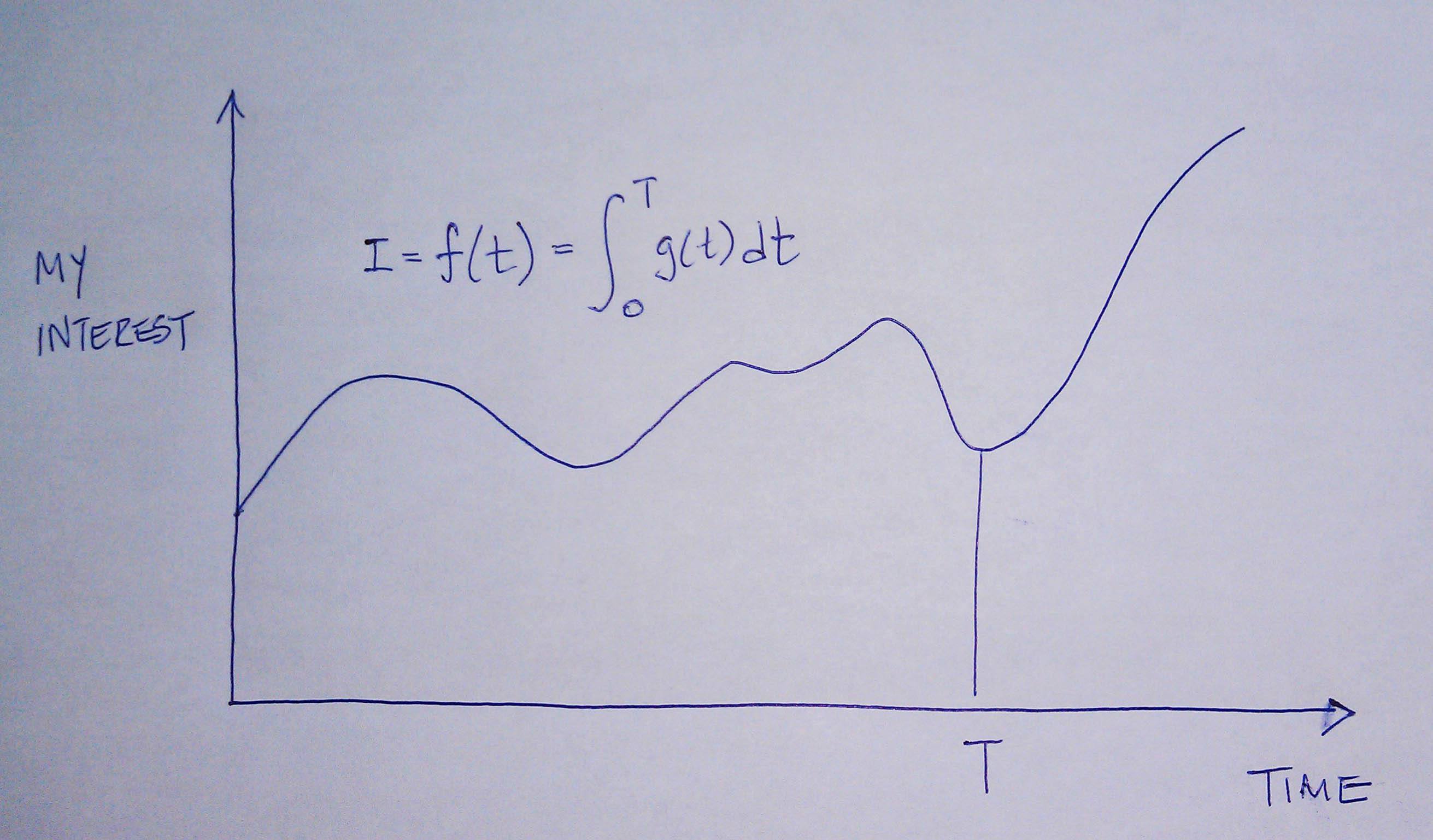
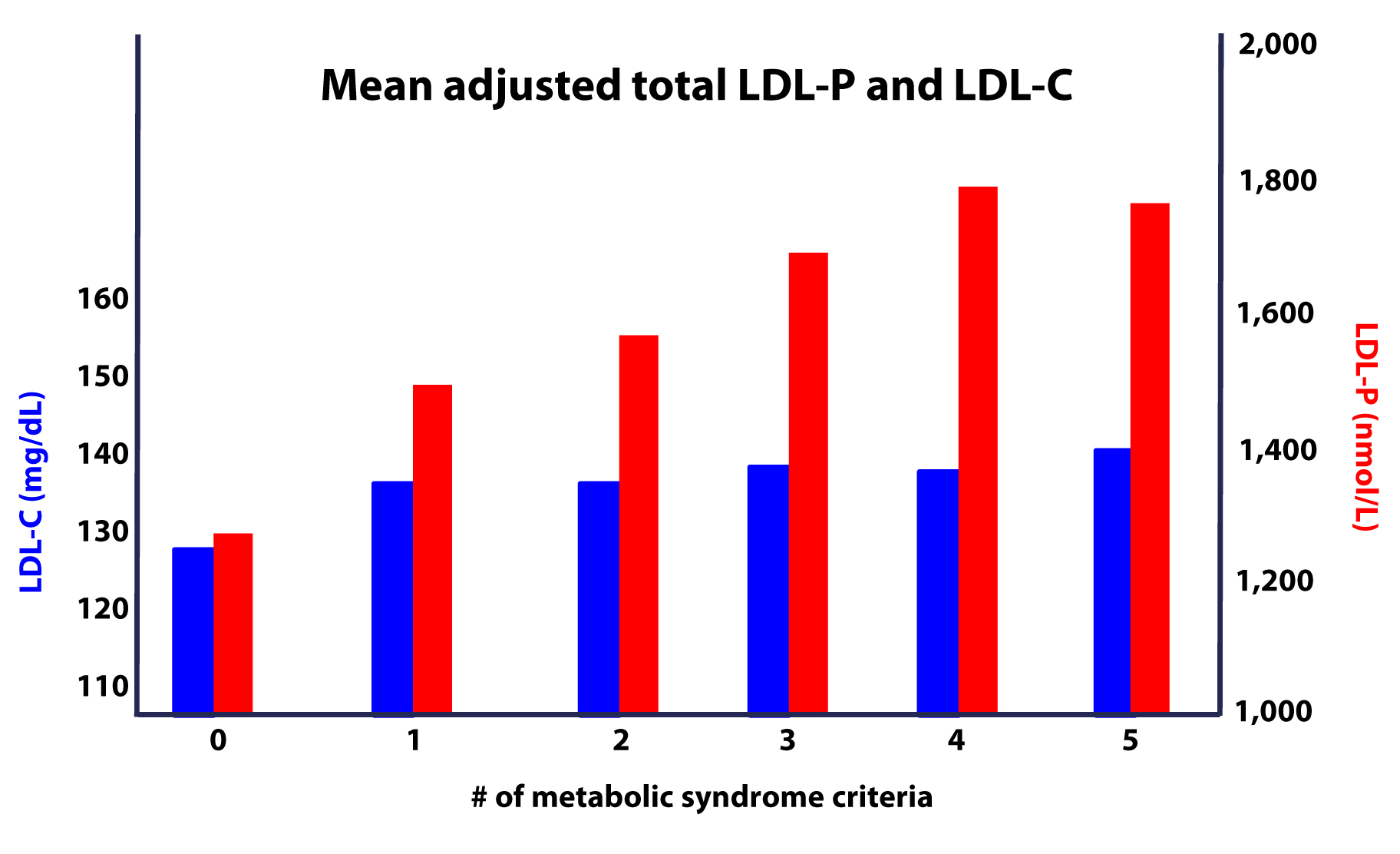
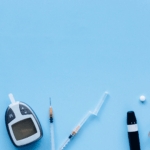
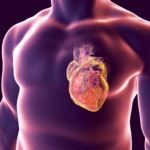
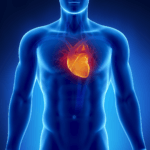

Hello Peter,
Great blog, great presentation (saw it on youtube), thanks for taking the time to share!
I’m getting increasingly concerned about my low cholesterol or the LDL at least. I have a Total of 4/154.67, HDL of 1.9/73.4, TG of 0.5/44 but my LDL was so low they had to lump it together and only gave me “non-hdl” which was 2.1 mmol/l (I don’t even know how to convert it).
I eat LOTS of fat, mostly saturated I guess (eggs, rare/medium-rare red meat, nuts, raw milk yogurt – nearly all on a daily basis). No gluten, grain, processed food or alcohol. Oh, and I also eat veggies 🙂 (probably not as much as I should though). I am lean but at the time when I checked the blood I was probably eating a bit – and by a bit I mean a lot – more fruit than I should (I have addressed this as I realized I had some severe glucose issues). I have a relaxed 16:8 eating pattern (eating during 8 hours only). I also supplement and at the time of the test I was eating Omega 3 oil every day (plus selenium , coQ10 and some other).
I have been trying to find out what’s going on and how to raise LDL but it seems like I am the only one around interested in that 🙂 I’ve looked at FHBL but the profile doesn’t really fit. I subscribe to the notion that food is information and that the body always (or almost always) makes the right decision according to the information that is available to it. Why would it be that I have such miniscule amounts of LDL?
Dr. Attia,
This is so fantastic, thank you so much for everything! I have read through this entire series & find it incredibly well presented & informative–Wow! I decided it was time to take better care of my health, instead of just sliding by. It’s been many years since I had my labs checked. I don’t even have access to the results at this point. I asked my current provider if we could check a cholesterol screen, but also add LDL-P, & Apo-A/Apo-B, & do a metabolic screen with glucose & insulin. I might add I am in my early 60’s, take bio-identical hormones, am lean & active, but have a family history of type 2 diabetes (mother) & CAVD (grandfather, brother). I would like to improve my diet & fitness.
I think my last cholesterol years ago was 205, with high HDL’s & a good ratio.
My provider declined to order the tests & said they were too expensive. I think we could make the case to the insurance co. He wants to refer me to a specilalist in cholesterol. My insurance deductible is very high & will not pay for a specialist. How does one get these tests done? Are mainstream internists unable to do them? I would appreciate any suggestions you might offer.
Thank you!
voluminous amount of volunteer work, thank you for your generous sharing..
You say that diet does not have much impact on cholesterol. I was diagnosed T2 a year ago with HBA1c of 7.8 and cholesterol of 5.1. I went vegan until my next tests and lowered my HBA1c to 5.8 and my cholesterol to 4.7 with HDLc and LDLc all within target ranges. A dramatic weight loss of 12kg occurred during this experiment. I assumed the diet was responsible as this was the only lifestyle change undertaken. After this, I adopted a LCHF protocol for 10 months . I reduced HBA1c a little further to 5.6 but my cholesterol sky rocketed to 7.4 and a big spike in LDLc to 5.2 (nmol/L) Again, you can’t blame me for assuming the drastic dietary change was responsible for the corresponding drastic cholesterol change. I was disappointed because I am loving the keto diet compared to the mostly raw vegan and even my wife joined in this time and dropped 10kg. How do you explain the radical cholesterol variations correlating with radical dietary interventions if diet has virtually insignificant impact on serum levels?
You hypothesise, as do I, that low carb reduces or even completely mitigates the risk associated with high cholesterol but I don’t want to be the lab rat for that test. My blood tests do not include particle number so my actual risk cannot be determined as you say. As I can’t think of any other interventions except the statins my doctor tried to push down my throat, reluctantly, I have to do another raw vegan stint to try and reproduce the same effect as last time. Im going to have to muddy the waters with this experiment by adding the exercise program Ive been meaning to start since my T2 diagnosis. I am more than a little concerned and highly motivated to get my “better than normal” (docs own words) cholesterol levels back. I would appreciate any further thoughts or advice you have considering my case
Thank you again
Doug G
Australia
Doug, you’ve misread what I said (you’re not alone). I did not say diet does not have much impact on cholesterol. I said dietary cholesterol does not have much impact on plasma (i.e., that which you measure in your blood) cholesterol.
Diet does, indeed, have an impact on not just cholesterol (less important), but also lipoproteins (more important).
Regarding the “dream study”, has this ever been attempted in reverse? That is, instead of randomly assigning a group acclimated to the standard American diet (SAD) to a low carb diet (LCD) you take a group of keto adapted/very low carb diet followers and randomly assign some of them to the SAD. Same length of time, same biomarkers as the dream study, etc. The scientific establishment assumes a high carb diet is the baseline and any LCD proponents have to argue against that point. Seems like starting with LCD subjects who have normal healthy markers and measuring the effect of a SAD should be a valuable data point. Apologies if this is easy to find, Google and Pubmed showed me nothing but I’m sure I could have searched better.
Also, thanks for the blog. It’s started a serious amount of thinking on my end.
Has not been done to my knowledge. Great thought experiment and, of course, “natural experiment.”
Dear Peter,
This series cholesterol has been amazing. Thank you!!!
Can you please help me with link for next part in this series?
This part ends as
“I would like to address one additional topic in this series before wrapping it up – the role of pharmacologic intervention in the treatment and prevention of atherosclerotic disease, so please hold off on questions pertaining to this topic for now.”
I haven’t written part X yet…
For those interested, there are a couple intriguing recent posts, over on Stephen Guyenet’s blog ( Stephen doesn’t support the carb/insulin hypothesis of obesity) and Denise Minger’s blog ( recall Denise expertly challenged the infamous China Study but she is now also looking more broadly at dietary interventions). I found these blog posts help broaden the perspective and discussion beyond simple low fat v low carb. https://rawfoodsos.com/ https://wholehealthsource.blogspot.com/
I have got such good info from “The Straight Dope on Cholesterol!” However, where is Part X? I have read parts I through IX and can’t find the next installment. Please post it if it is available. I’m left hanging.
Thanks
Still in my head.
Have you heard of Dr. Stephanie Seneff? She talks about the necessity of sulfur in removing LDL-P. She also has a lot to say about the correlation between glysophate (ie. Roundup) and many of the diseases we are seeing today.
I find the information that both of you offer to be fascinating.
Not familiar.
I’ve been following Seneff & Mercola on this issue & thought I had the answer. I got plenty of sun, ate garlic from my garden & daily broccoli and/or cauliflower or spinach. My last LDL-P was 3090 so it didn’t work for me. Still puzzled on the change since switching to a LC diet in March of 2014. My LDL-C was 68 before (LDL-P wasn’t measured before this) & now over 300 since (LDL-P >2400). I’ve started a statin to reduce that particle# since I’m out of ideas & it’s been over a year.
Great series Peter,
It is given me a great deal of food for thought.
Do you have much insight into what may be the cause of a rise in certain numbers within a standard Lipid Profile (particularly LDL-C and Triglycerides) after moving to a low-carbohydrate high fat diet? I’ve read a number of studies and anecdotal evidence, including a paper by Dr Dayspring, that seems to suggest it may be a genetic predisposition within some people to this type of Diet?
I wonder if these are the type of people who may be at less risk of developing Metabolic Syndrome following a high carbohydrate diet, probably no way to say for sure, at least not with the current evidence but it’s definitely got me thinking. I also wonder if the other benefits that seem to be associated with low-carbohydrate eating are not really there for this group of individuals.
I’m curious to hear your own personal thoughts on the topic.
Eagerly awaiting Part X as well, feels like I’m awaiting the next instalment of Game of Thrones!
Bill,
One of the things that Seneff talks about is sulfate deficiency. The cholesterol needs to combine with sulfate to be delivered to the cells. She recommends taking regular Epson Salt (Mag-Sulfate) baths. Can’t really hurt.
I’ve taken COQ10 for my heart a long time now, but have recently added NAC (glutamate precursor). I believe that she indicated that NAC is another source to increase sulfate. I was tested a couple a months ago and my LDL-C was too. I need to check to see if the tested for LDL-P. Since adding NAC, I’m feeling much better. I’m anxious to get tested again.
I hope things work out for you. I’d really be careful with the statins. I just had a good friend in his mid 30s tell me a story about his statin experience. He was driving with his kid and couldn’t remember who he was or who the kid in the back was. He had to pull his license out. Eventually everything came back to him, but it really scared him. He stopped taking the statins immediately.
Hope things get better for you!
Dan
I meant NAC is a precursor to Glutathione, not glutamine precursor although I believe glutamic acid is involved.
Dan
Thank you for all your hard work. I am reaping the benefits. In ketosis (testing my blood) since August. Lost 22 lbs! Feel great. My HDL is very low… 25 in August when I started, and 23 now after being keto adapted for 3 months. Can someone please give me a reason for why my HDL is not responding to this diet? I had a heart attack in 2013. I have done the test that shows I have more pattern B LDL. I convinced my doc that I could fix my cholesterol with this diet so he let me go off the Lipitor temporarily. Now my numbers aren’t so convincing.
I’ve listened to a Jimmy Moore podcast with Thomas Dayspring where he describes people with FH having the larger LDL particle size & particle number. He also said some develop horrendous atherosclerosis & some do not. I’ve got three sources of info that conflict with this assessment (2 from Uffe Ravnskov, 1 from A/Prof. Ken Sikaris).
Uffe Ravnskov YouTube video explaining why some with FH die early from heart disease. It’s not the higher cholesterol, but 3 other inherited factors that enables the blood to coagulate readily:
https://youtu.be/pMf3aFSdNag?t=15m45s
Document from Uffe describing the clotting factors (Fibrinogen & Factor VIII) in FH:
https://www.ravnskov.nu/the%20benefits%20of%20high%20C.htm
Ken Sikaris on LDL particle size & FH:
https://youtu.be/OyzPEii-wo0?t=7m43s
I still don’t know what the answer is to the high LDL particle count after switching to a low carb diet (when before the switch was “normal”) but can these sources I’ve listed be wrong? They seem convincing, but I’m not a medical professional & cannot decipher the info for validity like you and Taubes can.
You talk about the Quebec study & Mesa trial making an adjustment for the particle size & number, but has there been any on people with FH? After all, the change in particle number does seem to resemble FH. If anything, it may be interesting fodder for thought.
Will check out when I have time. I’m changing my tune a bit on particle size. I think the analysis I previously shared re: size vs. number may be flawed the way other studies of highly correlated variables can be flawed, especially if using ROC for the analysis.
It’s easy to slip back into the “cholesterol is bad” model when searching for atherosclerosis markers. I think this happens because we are still missing pieces in the whole atherosclerosis process and have a tendency to attach a cause/effect relationship to cholesterol and atherosclerosis. I think this is much more important to find these missing pieces than to try to reestablish these markers.
I believe the link below is a step to one of these missing pieces. Highlights are below.
– See more at: https://www.westonaprice.org/health-topics/abcs-of-nutrition/sulfur-deficiency/#sthash.Qmy3oVYx.dpuf
“The metabolic syndrome is a term used to encapsulate a complex set of markers associated with increased risk to heart disease. The profile includes (1) insulin resistance and dysfunctional glucose metabolism in muscle cells; (2) excess triglycerides in the blood serum; (3) high levels of LDL, particularly small dense LDL, the worst kind; (4) low levels of HDL (the “good” cholesterol) and reduced cholesterol content within the individual HDL particles; (5) elevated blood pressure; and (6) obesity, particularly excess abdominal fat. I have argued previously that this syndrome is brought on by a diet that is high in empty carbohydrates (particularly fructose) and low in fats and cholesterol, along with a poor vitamin D status.35 While I still believe that all of these factors are contributory, I would now add another factor as well: insufficient dietary sulfate.”
“Sulfur is a very versatile molecule, because it can exist in several distinct oxidative states, ranging from +6 (in the sulfate radical) to -2 (in hydrogen sulfide).”
“Like vitamin D3 sulfate, cholesterol sulfate is also water-soluble, and it too, unlike cholesterol, does not have to be packaged up inside LDL for delivery to the tissues.”
“One very special feature of cholesterol sulfate, as opposed to cholesterol itself, is that it is very agile: due to its polarity it can pass freely through cell membranes, almost like a ghost.”
“The three principal suppliers of sulfur to the Western nations are Greece, Italy and Japan. These three countries also enjoy low rates of heart disease and obesity and increased longevity.”
Dan
My older brother (54) recently underwent emergency quadruple bypass surgery (two arteries were 100% blocked, with natural tributaries, and two others, including the Widow Maker, were 70-80 blocked; fortunately, no infarctions or heart damage whatsoever). Our father, who died of lymphoma over 20 years ago at age 57, took Lipitor during most of his adult life. The brother, who I recently learned had total cholesterol levels above 300 for many years, refused to take any Lipitor-like drugs, opting instead for diet and homeopathic solutions, for various reasons that seem illogical to me.
Due to my brother’s event and our father’s history, my doctor recommended I have the NMR Lipoprofile study done. The results were mixed, with the following comment, “Small LDL-P and LDL Size are associated with CVD risk, but not after LDL-P is taken into account.” My doctor opined, “Your lipid profile is good. No medication is needed.”
All this prompted me to find and read your series, which immensely helped my understanding of my test results and my situation, but I definitely need to re-read many parts. Thank you for taking the time and effort.
Question: Both my dad and brother, besides sharing cholesterol problems, also had pronounced teenage acne. My oldest child (now 20) appears to have inherited my dad’s acne gene. I was wondering if there is any genetic or bio-chemical evidence to suggest a possible link to severe adolescent acne and subsequent elevated cholesterol.
Steve D.
I am not sure about the acne link, but familial lipid disorders (e.g., FH, lp(a)) must be ruled out in your son.
A heavy read for someone not medically trained, so please excuse me. If we assume that a person is not suffering any trauma (or other illness) would hs-CRP be a good marker for heart disease related illnesses?
It’s sort of a crude marker of risk. Even beyond trauma or overt illness, CRP can be high without necessarily reflecting a commensurate burden of CAD.
I just got my cholesterol results back, and they are sort of scary, especially the high LDL-P:
Total 294
LDL 225
HDL 60
HDL ratio 4.9
triglycerides 43
LDL-P 2024
LDL Small – 197
LDL Medium – 316
HDL Large – 3960
I am 37, fairly active, not at all overweight, and eat pretty well – am generally on a low carb-high fat diet, and eat lots of vegetables, coconut oil, avocados, etc – and not tons of sugar (certainly very little soda or candy). I already knew that I had a genetic cholesterol problem but had only ever had the standard lipid profile (LDL-C). This is the first time I’ve gotten the particle count tested, and it shows that indeed there seems to be something genetic going on. My questions are as follows:
1.) The test results (from Quest Diagnostics) for LDL-P show a “reference range” of “1016-2185 nmol/L” but then state my LDL-P number as 2024. What is the story with this range, and why is my “official” number so slanted towards the high end of the range? Could this be wrong?
2.) What can I do to improve my numbers? I’m willing to try anything really. Diet doesn’t seem to be much of a factor, though I’m thinking about switching to something closer to a Mediterranean paleo diet with less heavy consumption of saturated fat if that will make a difference. I really don’t want to take a statin drug, because I deeply fear the side effects. I suppose Red Yeast Rice would be preferable to Crestor or something like that, but I’ve also read RYR is basically no different from prescribed statins. Thoughts? Is a statin my only option? Is there any point to me taking niacin? Is there anything else I can try?
Any advice you have would be most appreciated. Thanks.
I’d discontinue the coconut oil and other such obvious sources of saturated fats and replace them with a couple of spoonfuls of macademia nut and ev-olive oil rich in monounsaturated fats. My cholesterol plummeted from 8.3 mmol/L to 6.1 mml/L and my ApoB went from 1.34 to 1.06 g/L. Apo-AI is now 1.35 g/L. Both ApoB and Apo-AI are within the reference ranges.
Cal, my numbers are very similar to yours. Have you made the adjustments and seen a change in your numbers? I am very curious.
Hi Dr. Attia,
I just recently discovered your blog. I personally have done the protein sparing modified fast three years ago under a doctor and lost a lot of weight. Since then I have gained it all back and have been diagnosed with prediabetes and high cholesterol. My doctor is again letting me do the fast, which only allows 10 carbs a day. With this certain diet you are knocked into ketosis and are suppose to restrict your fat amount. I am just curios how do you not feel tired all the time when doing it? And how would you suggest maintenance when I am happy with where my weight is and have less health problems?
Kayla
will ldl reduce without any medication? i mean with good diet and exercise
Great stuff!!!
Recently there was a youtube video making an argument against eating eggs. Although your series addressed a few of his points, there were a few other good points I was hoping you could address
https://www.youtube.com/watch?v=YaIpaGSESO0
Regards,
Hello,
Found this blog a couple of weeks back and have been going over this series. Extremely interesting and informative. So, Thank you.
Am not sure if you were planning on covering this in your next articles, But it seems that LDL Particle Number, ApoB and Amount of Small LDL Particles are better indicators of cardiac health. So what should be the prescribed method for someone who has those symptoms? Should statins be the first step, combination of statin with something else or something other than statin?
Thanks again